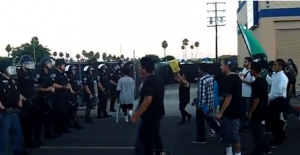Unrest In Anaheim Could Lead To More Latino Representation
 By Tony Castro, Voxxi
By Tony Castro, Voxxi
Historically, at-large election districts were the way white majorities controlled cities and towns where minority groups could do little more than flay at the political power structure that usually held every political office in those communities.
In 1964, the U.S. Supreme Court’s one-man, one-vote decision brought equality to state legislative districts, but at-large districts—especially in local city council and school board elections—remained untouched until almost city-by-city they came under voting rights legal challenges.
Today, the city of Anaheim remains the largest city in California where voters still elect council members on an at-large, citywide basis. In Anaheim’s 150-year history, only three Hispanics have ever served on its city council.
But all that may be nearing an end.
On Thursday, the Anaheim City Council will decide whether to put a question on the November ballot and allow residents to determine how council members are elected in the future—citywide as they have in the past or in individual districts that would give a larger voice to neighborhoods and minority groups.
Mayor Tom Tait, who supports changing the way the council is elected, says there is an inevitibility in single-member districts.
“I think Anaheim is ready,” Tait told Voxxi. “I think the people of Anaheim, in all parts of the community, want and deserve (more direct) representation.”
Of course, it is not exactly, as if Anaheim has much choice. Like other cities across the country that have switched to single-member district voting, Anaheim is facing a lawsuit that could ultimately give courts not only the power of the decision, but also of how the district lines are drawn.
By passing a ballot measure approving single-member districts, local officials could also retain control over their implementation as well as how the individual districts are created.
Anaheim, after all, is more than just any little big town. It is home to Disneyland and to the Angels Major League Baseball franchise. It has a population of 336,000 going through both rapid development and a mushrooming Hispanic population. Latinos make up 52 percent of the residents, though a far lower percentage of the city’s voters.
It is also not overly simplistic to describe Anaheim as a city of haves and have-nots. The wealth of the city is in the predominantly white areas, most notably “The Hills,” as the affluent section is called. Critics complain that power on the City Council has led to The Hills having a disproportionate share of the parks, libraries and other resources.
The Hills are also home to four of the city’s five council members. The fifth resides in an exclusive historic area known as The Colony. The only Latino representative is a councilwoman who is half Hispanic and half Philippine.
The have-nots live primarily in the city’s central core bordered by two freeways and made up mostly of low-income Latino barrios.
“It’s an area that goes largely ignored,” says resident Felix Gonzales, a waiter. “But it’s now at the forefront because of what’s happened.”
What’s happened was the police killing last month of an unarmed 25-year-old Latino, whose death triggered four days of protests and underscored half a dozen Anaheim police-shootings of Hispanics this year alone. A second Hispanic man was shot and killed by police a day after the first.
Facing the prospect of ongoing unrest in the city, Anaheim officials called upon the U.S. Justice Department to examine whether a full federal investigation is warranted.
The latest police shootings could not have come at a worse time for city leaders nor a more opportune moment for Hispanic activists seeking a change on how Anaheim elects its city officials.
Jose Moreno, a Cal State Long Beach professor and president of the Los Amigos of Orange County, the organization which is suing for single-member council districts, says the shootings and protests are symptomatic of Anaheim failing to reflect its demographic changes and the distrust that has created.
“What we’ve got here in Anaheim is concentrated power in the hands of a wealthy minority, a working-class and a working-poor Latino majority that feels it has no voice coupled with completely uneven distribution of the city’s resources,” says Moreno, a trustee on the Anaheim school board.
And single-member districts could go a long way in healing the distrust, he added.
“Police don’t do their work in a vacuum,” he says. “For them to rebuild relationships in our communities, we need to feel like part of the political system—like we are sharing in the resources of this city.”
This article was first publisehd in Voxxi.
Los Angeles-based writer Tony Castro is the author of the critically-acclaimed “Chicano Power: The Emergence of Mexican America” (E. P. Dutton, 1974) and the best-selling “Mickey Mantle: America’s Prodigal Son” (Brassey’s, 2002). His rite of passage memoir, “The Prince of South Waco: Images and Illusions of a Youth,” will be published in 2013.
[Photo screengrab from video by imGabesss]
